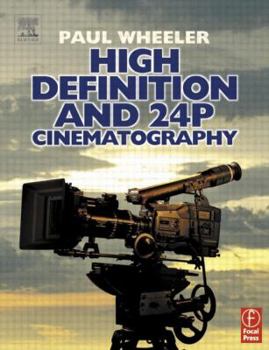High Definition and 24p Cinematography
This authoritative new reference demystifies the technologies of high definition and 24P cinematography. It is written for the director of photography, camera crew and producer or director and deals with the subject from their point of view. It provides a thorough and logical description of the five scanning formats 24P, 25P, 30P, 50i and 60i as well as recording formats, editing options, delivery potential and discussions on the financial implications theses decisions might have. It looks at comparative costs between different decisions surrounding camera formats, such as 16mm to 35mm shooting for different examples, such as a 100-minute low budget movie or 30 second commercial. There is also considerable discussion on the advantages and disadvantages of using HD versus film, seen from a producer's perspective and what the impact is on all those involved in making a movie. Different delivery systems and camera equipment are discussed as well as editing. Filled with practical advice for tackling everyday decisions and choices, this is a must-have guide for anyone using or considering using high definition technology.
Format:Paperback
Language:English
ISBN:0240516761
ISBN13:9780240516769
Release Date:March 2003
Publisher:Focal Press
Length:240 Pages
Weight:1.45 lbs.
Dimensions:0.5" x 7.4" x 9.8"
Related Subjects
Arts, Music & Photography Counseling Direction & Production Education Engineering Equipment, Techniques & Reference Film & Television Humor & Entertainment Industrial, Manufacturing & Operational Systems Job Hunting & Careers Movies Performing Arts Photography Schools & Teaching Television Visual Arts Vocational GuidanceCustomer Reviews
1 rating
Very accessible and useful!
Published by Thriftbooks.com User , 20 years ago
The world of HD and progressive/interlaced technology can be very complex and confusing, and I've read several technical books that keep it that way. Paul Wheeler does a superb job of being concise, clear, and extremely practical. This is the first time I've read a comparison of HD and film that was unambiguous and unemotional. I get the similarities and differences now more clearly than ever. He also goes thru the various (confusing) frame rate choices and actually lists the practical situations where you might choose one over another. Astounding! And, lastly, I greatly appreciate his confidence when he says, basically: take care to set up your camera carefully (and here are the steps), take care to set up your monitor carefully (and here are the steps), and then don't fret about creating a perfect waveform--trust what you see and be creative. There is also a great deal of user-friendly description of camera types, lenses, setups, etc. which I won't directly use in my work as an editor, but they were engaging and informative, so I didn't skip over them and learned a thing or two in the process. He has some partisan preferences in terms of brands and models, but states that all up front and clearly.Most excellent!





